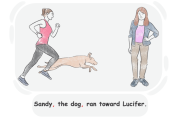Comma
In this lesson you will learn about advanced comma rules for clarity and emphasis in writing. Master them with challenging examples and exercises.

What Is a Comma?
A comma is a punctuation mark that is used to separate words, phrases, or clauses within a sentence. Commas help to clarify the meaning of a sentence and make it easier to read by indicating where to pause or where there is a change in thought.
Comma: Uses
A comma is usually used to make a pause between words, phrases, or clauses. It can also be used to group words or to separate clauses. For instance:
They went through many things, illness, divorce, depression, etc.
Do not forget to buy oil, eggs, and vegetables.
In general, commas are used:
in lists
after some adverbs
to separate clauses
before coordinating conjunctions
after dependent clauses
to offset non-restrictive structures
to group adjectives
to tell the date
to address directly
with negatives
in numbers
Comma in Lists
When we want to list some nouns or items in a group, we use a comma between them. Here are the examples:
I had soup, fish, pudding, and coffee for dinner.
I have invited Sam, Peter, and Diego.
Comma in Direct Speech
When reporting a direct speech, there is always a comma between the quoted speech and the introducing clause. Check the examples:
He said, "I am not going to kiss her."
"We will talk about it later," she replied.
Tip!
Remember, when a comma meets a quotation mark, we should use it before the quotation mark. Here are the examples:
"We will win," they said.
"Read it please," she mumbled.


Comma and Coordinating Conjunctions
Before coordinating conjunctions that link two independent clauses, a comma is used to separate the two clauses. Here are the examples:
Neither I wanted to go out, nor I liked to stay home.
We started to run, and soon I felt frustrated.
Comma and Clauses
Sometimes there is a need for a pause in the sentence, this helps clarify the context. For example:
He smiled, I had not sees him smile before.
This is not finished, there is a lot to talk about.
Comma and Adverbs
When an adverb is used to modify a whole sentence or when it is used to start a sentence, you have to use a comma after it. Remember, the adverb has to apply to the whole sentence. Check out these examples:
Usually, I try to stay silent and listen more.
No, I would never cheat on you.
Comma and Dependent Clause
A dependent clause is always separated from the independent clause using a comma. Here are the examples:
Although it might be difficult at first, you will learn how to shoot in the basket.
When she arrives, I will take her to the club.
Commas and Non-restrictive Structures
Non-restrictive structures are offset by commas, and they can be removed from the sentence without affecting its meaning or completeness. For example:
Sandy, the dog, ran toward Lucifer.
My uncle, who lives nearby, is my father's only brother.
Comma with Adjectives
When we want to use a list of adjectives to describe a person or thing, we can use a comma between the adjectives. Remember, to do so, the adjectives have to be interchangeable. Here are the examples:
There was a big, fascinating, marvelous wedding there.
You are beautiful, nice, kind, and polite.
Comma with Dates
We use a comma between the main parts of dates. Here are the examples for more clarification:
April 1st, 1999, he was waiting at the station for her to come.
Saturday, May 15th, 2005, is the last thing I remember.
Comma with Titles
When we use honorific titles or names to address people directly, there is always a comma following them. Check out these examples:
Doctor, could you please be totally honest.
Professor, there is something I want to talk about it.
Comma with Negatives
When a negative statement follows a positive one, we have to use a comma between the two statements. Here are the examples:
It is a cat, not a bird.
Take the bananas, not the oranges.
Comma with Numbers
When writing numbers using digits (not letters), it is customary to use a comma to separate every three digits from the right, in order to make the number easier to read and understand. Here are the examples:
3,000,000
50,054,956
Review
There are occasions in which you have to use a comma such as:
in lists
after some adverbs
in direct speech
to separate clauses
before coordinating conjunctions
after dependent clause
to offset non-restrictive structures
to group adjectives
to tell the date
to address directly
to use negation
to tell numbers
Comments
(0)- What Is a Comma?
- Comma: Uses
- Comma in Lists
- Comma in Direct Speech
- Comma and Coordinating Conjunctions
- Comma and Clauses
- Comma and Adverbs
- Comma and Dependent Clause
- Commas and Non-restrictive Structures
- Comma with Adjectives
- Comma with Dates
- Comma with Titles
- Comma with Negatives
- Comma with Numbers
- Comma with Question Tags
- Review
